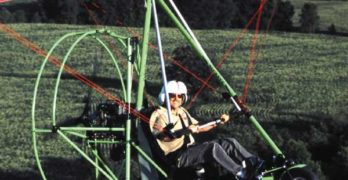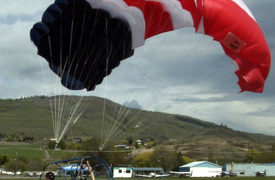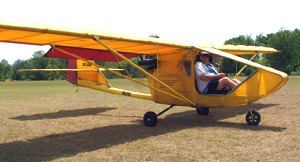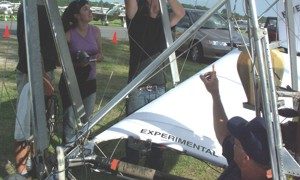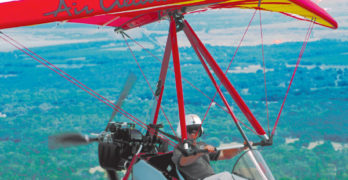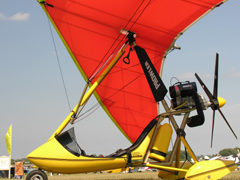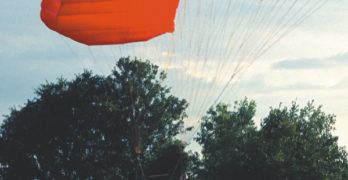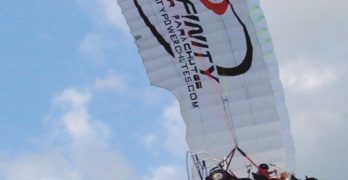Air Création is a serious company and a world-class trike builder with an impressive sales record. Their serious trikes sport beautiful hardware and numerous customized components. Right down to their trademark red color, Air Création is serious about building a remarkable trike, a series of them in fact.
So when Air Création puts a float set on the market, you can count on the fact that it was well researched and exquisitely crafted.
Now, let’s combine that with the XP-17 wing, the largest in the company’s XP series. Floats are mounted under and the wing atop a GTE trike carriage which has been in production for several years. Put this all on a lake in Florida and you have the makings of an interesting experience.
Another 20-Year Veteran
Gilles Bru and Jean Yves le Bihan founded the French company in 1982. Air Création’s dealer in Canada reports, “It has grown steadily ever since, building around 4,000 wings and 2,500 trike-units for sale in more than 50 countries.”
Today Air Créationemploys 25 people, four of whom are in the technical department designing new products, and 14 work on the production of ultralight trikes and wings.With annual sales of about $2.5 million, Air Création exports 60% of its products.
Search Results for : Part 103
Not finding exactly what you expected? Try our advanced search option.
Select a manufacturer to go straight to all our content about that manufacturer.
Select an aircraft model to go straight to all our content about that model.
Buckeye Convertible
I never really noticed before just how much the Buckeye Industries powered parachute carriage looked like a trike carriage. Maybe you didn’t either, but in your mind’s eye, remove the prop guard and see if you don’t agree. They aren’t identical, of course, but the visual relationship is uncannily close considering the two aircraft types developed separately.
What a perfect situation. Ralph Howard’s family members and friends have built Buckeye from “nothing” to one of the world’s largest aircraft manufacturers, all in the ’90s and without even using the entire decade! Whatever combination of talent, money, timing and luck was involved in this tale of success, the Howards want to keep it going strong. That won’t be easy, but these Indiana Hoosiers may be up to the task.
Take the momentum of a reported several hundred powered parachute units sold each of the last few years. Revise the hardware slightly to expand into the manufacture of trikes, and you have a potent mixture that could emerge as one of America’s largest trike builders.
First-Ever Powered Parachute SLSA Approval!
Summit Powered Parachutes beat a group of companies working toward the first Special Light-Sport Aircraft PPC. The Vernon, British Columbia, Canada-based powered parachute producer won their SLSA Airworthiness Certificate on Thursday, April 27, 2006. I flew and reported on the Summit II in the 11/03 edition of Ultralight Flying! Magazine. I found Summit II to be notably different than most other powered parachutes partly due the sliding rudder pedal-like foot controls used to steer the canopy that exhibited fluid action. Last November Summit won German certification in the only such approval by an American company with which I am familiar. This earlier certification may have helped Summit as they prepared for stating compliance to the quite different ASTM standards. Although the powered parachute standard has been done for many months, those producers have not rallied to the new regulation. All that may change now that Summit is out of the gate with their approval.
Number One CGS Hawk Retires to Florida Air Museum
Back when the term “ultralight” was new…back in spring of 1982 before FAA issued their now-classic Part 103 regulation…and during the time when ultralights still had to prove themselves by being foot launchable…that’s when bold designer Chuck Slusarczyk introduced the first CGS Hawk at the then-new Sun ‘n Fun Fly-in. It was fully enclosed (you couldn’t foot launch it and all other ultralight were open cockpit airplanes). It had conventional three axis controls (unusual then). But this “outlaw” design proved to be a hit. Over the years, CGS and Chuck have sold over 1,500 Hawks! Now, fittingly, a Hawk has been inducted into the Florida Air Museum. Even more fittingly, this followed one last flight from the airstrip at Sun ‘n Fun’s Paradise City ultralight display area. At the end of the flight, Chuck taxied back one last time. It was a bit emotional to retire Hawk #1, he says.
Pioneer in Ultralight Industry Still Going Strong
John K. Moody is widely acclaimed as the “Father of Ultralights,” and he makes effective use of that unique title to publicize his new millennium act featuring his last millennium ultralight.
Is Moody really the father of ultralights or the first to fly one? Several other enthusiasts were experimenting with power units for various kinds of hang gliders in the mid-1970s when Moody started. His distinction was that he was the first person to foot-launch and climb from flat terrain without benefit of wind or a slope.
I saw Moody fly in the summer of 1975 when he performed before about 250 hang glider pilots in a contest on the sand dunes near Frankfort, perched on the eastern shore of Lake Michigan. He began this risky behavior on March 15, 1975, above a frozen lake southwest of Milwaukee, at age 32.
Into almost still winds at the end of a day of hang-gliding competition, Moody ran his heart out and coaxed his Icarus II biwing hang glider off the beach with a 10-hp West Bend engine giving him some push.
Tom Ivicevich’s Wright Flyer
The Wrightness of one man’s dream
On December 17, 2003, Tom Ivicevich’s Wright Flyer won’t represent the only attempt to recreate the brothers’ famous accomplishment. Nor will he be the only Wright pilot flying cross-country to arrive at the sand dune shrine in Kitty Hawk, North Carolina. But Ivicevich will do it all without major sponsorships. And he intends to fly coast to coast in his enhanced version of the original Wright Flyer.
This is one man’s dream, and he is well underway to reaching his goal.
Creating Interest
In January this year, Ivicevich’s 5¼8-scale Flyer flew while being towed by a 1930 Model A pickup truck at Redding Municipal Airport in California. The 190-pound aircraft took readily to the air at 25 mph.
In February, Ivicevich announced, “I am now organizing the start of construction for the full-size Flyer.” Next year, he plans to launch from Torrance, California, and make his way across the country.
Air Creation Buggy/Kiss
For many years, I’ve been critical of trike handling. While I try never to forecast the future, I’ve gone out on a limb and predicted that rigid-wings will eventually become commonplace on trikes (though I don’t also predict delta wings will disappear).
Going Rigid?
Rigid-wings look a lot like modern hang gliders and trike wings in many ways, but they have control surfaces. Because these surfaces are deployed via weight-shift movements they neatly combine the benefits of 3-axis ultralights – lower control forces and good control authority – with the elegant simplicity of weight-shift. Rigid-wings can carry good weight and are somewhat faster than delta wings (called “flex wings” by hang glider pilots), and they also handle more easily. I think this makes them a nearly inevitable development.
While I still believe rigid-wings are coming to trikes, it may take longer than I thought because the trike industry may finally be rising to the challenge.
Super Sanitary Trike: Prowler
Don Cooney’s Prowler is one clean machine with a number of cleverly designed components that set this uncommon American trike apart from the rest, even Europe’s highly engineered brands. The small double-surfaced wing resembles Britain’s Chaser but has been subtly modified to improve the shape. The trike carriage has a elegantly simple rear structure and engine mount supporting a Rotax 447. Prowler’s nosewheel uses a single sturdy strut and hydraulic brake. A simple instrument panel has the right (few) gauges and a holder for a radio. On whole, the Part 103-legal Prowler is one of the most smartly designed trikes in the fleet. Sitting low and comfortable, I can’t wait to fly it. Watch for my article in the December 2005 Kitplanes magazine.
Hybrid Powered Chute
As focus sharpens on FAA’s proposed Light-Sport Aircraft regulation, the first aircraft segment to complete an ASTM airworthiness consensus standard is powered parachutes. While these aircraft are simpler, which helped speed the process, participating manufacturers got together well and hammered out their certification rules efficiently.
Summit Powered Parachutes of Canada hasn’t yet chosen to enter the Light-Sport Aircraft arena. They aren’t worried, just wary of new regulations. In fact, the company started work under England’s BCAR S regulation. Just recently, Summit was working to qualify for German DHV certification. They see no great challenge passing the proposed U.S. powered parachute standards, as currently defined.
Fortunately, the proposed Light-Sport Aircraft is not the only destination in sport aviation. It may be part of the spectrum of aviation regulations.
We’re seeing more new designs tuned to Part 103. And the Amateur-Built 51% rule will still allow many 2-seat ultralights to be built and flown as they are today.
Infinity Power Parachutes
On a warm summer evening, a large field of 3-foot-tall oats sways gently in the breeze. In this pastoral setting a runway is cut down the middle. The farmer who owns this field has a light aircraft he flies from his country property, and he’s kind enough to allow Tim Norling, a local powered parachute pilot, to use it, too. Norling operates Let’s Fly, an Infinity powered parachute dealer 20 miles north of Minneapolis, Minnesota.
By the time Norling gets his Infinity powered parachute set up, the winds have quieted down, as we hoped they might. It is a beautiful evening for flying in Minnesota, and I am ready for a flight.
Some pilots say, “Oh, those powered parachutes are too vulnerable. You can only fly them in gentle winds.” Yeah, so? Is it really imperative to fly in strong winds? Is being restricted to mild conditions a bad thing?
Powered parachutes tend only to be flown when it’s pleasant to do so.
- « Previous Page
- 1
- …
- 32
- 33
- 34
- 35
- 36
- …
- 53
- Next Page »



